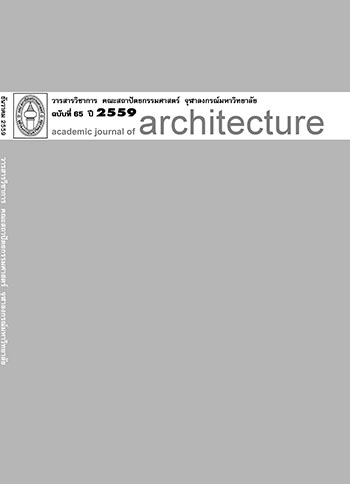Architectural Style of Coconut Orchard Vernacular Houses in Ko Pha Ngan, Surat Thani
Main Article Content
Abstract
Modern tourism that comes with capitalist society and economy led to changes in the way of life of the people in Ko Pha Ngan, Surat Thani Province. As a result, vernacular houses of the coconut orchard areas on the island were dismantled or modified from the original condition. This research is an attempt to record the essential features of these coconut orchard vernacular houses, using the framework of vernacular architecture research methodology. The study was based upon five vernacular houses selected as case study, then evaluated and summarized. Modern tourism that comes with capitalist society and economy led to changes in the way of life of the people in Ko Pha Ngan, Surat Thani Province. As a result, vernacular houses of the coconut orchard areas on the island were dismantled or modified from the original condition. This research is an attempt to record the essential features of these coconut orchard vernacular houses, using the framework of vernacular architecture research methodology. The study was based upon five vernacular houses selected as case study, then evaluated and summarized.
The study reveals that the coconut orchard vernacular houses in Ko Pha Ngan were defined by functional consideration based upon social and cultural requirements, together with site-specific environmental conditions. The houses were located nearby each other to provide supportive relationship in communities, while the layout and orientation of the houses in the north-south axis was climatically defined to enhance natural ventilation and protection from direct sunlight. These houses were lifted above ground and place on columns, enclosed on all sides with wooden partitions. The roof slope is less apparent resistance to the wind and the rain. The building was made of local wood that can be found in the island. The characteristics of the houses represent valuable local wisdom in architecture and construction of Pha Ngan people.
Article Details
References
พิมล มีเพียร. “มารู้จัก เกาะพะงัน.” ใน เอกสารที่ระลึกในโอกาสงานเปิดป้ายที่ว่าการอำเภอเกาะพะงัน จังหวัดสุราษฎร์ธานี. (ม.ป.ท.), 2521.
ภาณุพันธุวงศ์วรเดช, สมเด็จเจ้าฟ้า กรมพระยา. ชีวิวัฒน์. พระนคร: โรงพิมพ์โสภณพิพรรฒธนากร, 2471.
วุฒิ ชมอินทร์. “ฝันกลางวัน.” ใน เอกสารที่ระลึกในโอกาสงานเปิดป้ายที่ว่าการอำเภอเกาะพะงัน จังหวัดสุราษฎร์ธานี. (ม.ป.ท.), 2521.
สภาวัฒนธรรมอำเภอเกาะพะงันและสำนักงานศึกษาธิการอำเภอเกาะพะงัน. รายงานการศึกษาข้อมูล ชุมชนวัฒนธรรม เกาะพะงัน. (ม.ป.ท.), 2539.
สารานุกรมวัฒนธรรมไทยภาคใต้ เล่ม 2. กรุงเทพฯ: มูลนิธิสารานุกรมวัฒนธรรมไทย ธนาคารไทยพาณิชย์, 2542.
อารมณ์ พงศ์พงัน. บ้านเกิด. กรุงเทพฯ: โรงพิมพ์รุ่งวัฒนา, 2522.
เอกวิทย์ ณ ถลาง. ภูมิปัญญาทักษิณ. พิมพ์ครั้งที่ 2. กรุงเทพฯ: อมรินทร์, 2544.
จบ ใจเสมอ, ชอบ เมืองทอง, มนัส พรหมเจริญ, สมโภชน์ พรหมเจริญและสังวาลย์ ทองอ่อน. สัมภาษณ์โดยผู้เขียน. 9 มีนาคม 2556.
ประพาส มะเดื่อหวานและสุวิทย์ ผ่องศรี. สัมภาษณ์โดยผู้เขียน. 17 ตุลาคม 2556


